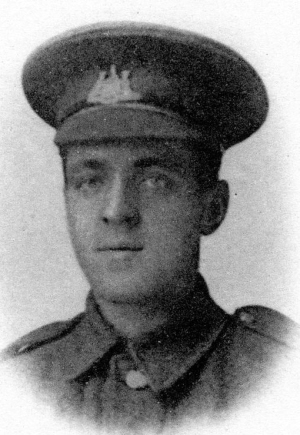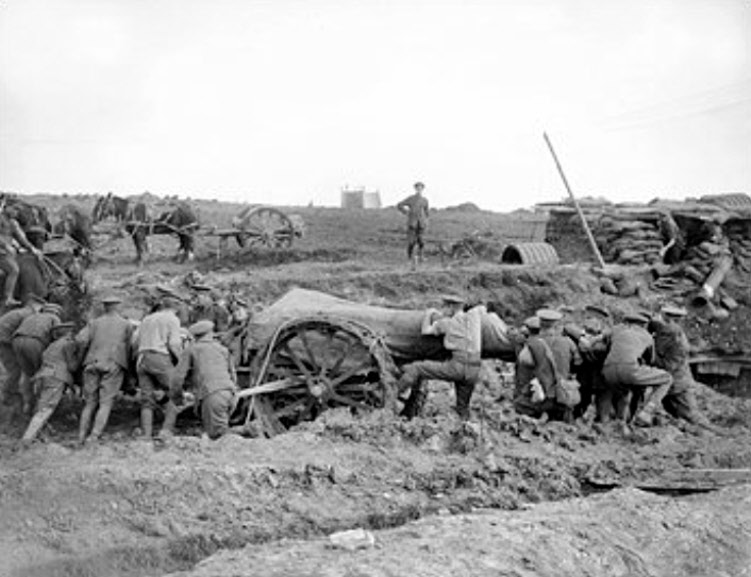
William Henry Phillips was born in Ossett in 1893, the third child and eldest son of wool sorter George William Phillips and his wife, Lucy (nee Jackson) who married in 1887. The couple had six children, but sadly two died before April 1911. George William Phillips died in late 1899 aged 38 years and in 1901 and 1911 widow Lucy Phillips was living on Healey Road with her four children aged between 16 and 22 years, who were all born in Ossett. In 1911, William Henry Phillips was working as a scribbler-feeder for a mungo manufacturer.
William Henry Phillips’ army service record has not survived. but it is known that he enlisted at Colsterdale, North Yorkshire on the 7th June 1915 and joined the 11th Battalion of the Prince of Wales’s Own (West Yorkshire Regiment), with service no. 15/1466. He embarked for France before September 1916 and was killed in action on the 7th October 1916 during the Somme campaign. He was posthumously awarded the British and Victory medals, indicating that he did not serve overseas before the 31st December 1915.
The 11th (Service) Battalion, West Yorkshire Regiment (Prince of Wales’s Own) was formed at York, on the 10th October 1914, as part of Kitchener’s Third Army. They joined 69th Brigade, 23rd Division. 23rd Division was established in September 1914 as part of Kitchener’s Third New Army, and concentrated in Hampshire in September with 68th Brigade at Bullswater. As the winter set in, the Division moved to Aldershot. At the end of February 1915 they moved to Shorncliffe, Kent, and some of the infantry were engaged in constructing defences to the south of London in April and May, before the Division moved to Bordon, Hampshire at the end of the month. They proceeded to France in the third week of August, landing at Boulogne and concentrating near Tilques.
On the 5th of September 23rd Division became attached to III Corps, moving to the Merris-Vieux Berquin area, for trench familiarisation under the guidance of the 20th (Light) and 27th Divisions. They took over front line sector between Ferme Grande Flamengrie to the Armentieres-Wez Macquart road in their own right on the 14th. During the Battle of Loos CIII and CV Brigades RFA were in action attached to 8th Division. With 23rd Division holding the front at Bois Grenier, they were relieved from that sector at the end of January 1916 and Divisional HQ was established at Blaringhem with the units concentrated around Bruay for a period of rest. On the 3rd of March they returned to the front line, taking over a sector between the Boyau de l’Ersatz and the Souchez River from the French 17th Division, with the Artillery taking over an exposed position between Carency and Bois de Bouvigny where it was subjected to heavy shelling.
In early March a Tunnelling Company was established and men with a background in mining were transferred from the ranks to the Royal Engineers. In Mid April they returned to Bruay area for rest until mid May when they again took over the Souchez-Angres front, just before the German Attack on Vimy Ridge on the 21st. The brunt of the attack fell on 47th (London) Division, to the right of 23rd Division and the 23rd Divisional Artillery went into action in support of the 47th. On the 1st of June the Artillery supported 2nd Division as they undertook operations to recover lost ground. On the 11th of June the 23rd Division Infantry moved to Bomy and the artillery to Chamblain Chatelain and Therouanne to begin intensive training for the Battles of the Somme. They were in action in The Battle of Albert including the capture of Contalmaison, The Battles of Bazentin Ridge, Pozieres, Flers-Courcelette, Morval and The Battle of Le Transloy including the capture of Le Sars.
Private William Henry Phillips was killed in action during the Battle of Le Transloy on the 7th October 1916. The battle, which opened on the 1st October 1916, began well with the capture of Eaucourt L’Abbaye by the 47th (1/2nd London) Division as well as an advance along the Albert-Bapaume road towards Le Sars. The advance was resumed on the 7th October and Le Sars was taken by the British 23rd Division but progress along the Canadian lines stalled. The “War Diary” for the 11th Battalion of the West Yorkshire Regiment has this:
“On the 5th and 6th October 1916, the battalion were in trenches round and about 26th Avenue. On the 7 October at 2.10 pm the Battalion attacked trenches to the left of Le Sars, objective gained and held, losses heavy with 8 officers and 217 other ranks killed.”
The book “West Yorkshire Regiment in the War: 1914-1918” by Everard Wyrall confirms this position:
“Meanwhile on the left of Le Sars, the 11th West Yorkshires (Lieut.-Col. Barker) had moved to the assault at 2.05 pm but were at once met by a heavy rifle and machine-gun fire from both the front and left flanks: the enemy’s artillery also shelled the area over which the attack was going forward. This bombardment had, unfortunately, caught the two supporting companies of West Yorkshiremen who, five minutes earlier (2.00 pm) had endeavoured to cross from Destremont Farm to the First Flers Line. Of these two companies, only two unwounded officers and thirty other ranks reached the Flers front line.”
The “Ossett Observer” 1 had this obituary for William Henry Phillips:
“A Missing Ossett Soldier – Officer’s Tribute To His Conduct – Private William Henry Phillips, whose widowed mother lives at 13, Healey-road, Ossett, is now officially reported as missing after an engagement in France on the 7th October. Three or four weeks ago, one of his comrades wrote that he was believed to be killed and that he died a hero’s death, while the casualty list gave his name among the wounded. Now his mother has received the official notification that he is missing.
His mother, not having heard of him for two or three weeks, she wrote to an officer in the West Yorkshire Regiment, to which the soldier was attached and has received the following kindly reply:
‘Dear Mrs. Phillips – Your letter of the 1st inst. is by no means an intrusion. My only regret is the little delay in answering it, due to the battalion being in the trenches until lately. In a recent action your son was last seen doing very good work in the dressing of the wounded, but when the action was closed he was found to be missing. I am unable to say definitely that he was killed, and there is quite a possibility that such is not the case, but I regret to say that we have been unable to trace him since. Both his comrades and his officers speak very well of his work in the action in question, and of his demeanour generally amongst his chums, as a soldier and as a friend, and all join with me in regret at his loss to the battalion and this company. Should any more definite information come to hand it will be at once sent on to you.’
Private Phillips is 23 years of age. He has been in the army since the 7th June 1915. In September he was in hospital suffering from shell shock, but returned to the trenches on October 3rd, only four days before he was last heard of. Prior to the war he worked for Messrs. Eli Townend Ltd., at Healey, and was well-known in local junior cricket and football circles, being connected with the South Ossett Church Institute Cricket Club and Healey-lane Albion Football Club.”

Above: British soldiers moving artillery at Transloy Ridges in October 1916.
Private William Henry Phillips, aged 23 years, son of Mrs. Lucy Phillips, of 13, Healey Road, Ossett, died on the 7th October 1916. He is remembered at Pier and Face 2A, 2C and 2D at the Thiepval Memorial, 2 Somme, France. The Thiepval Memorial will be found on the D73, next to the village of Thiepval, off the main Bapaume to Albert road (D929).
On 1 July 1916, supported by a French attack to the south, thirteen divisions of Commonwealth forces launched an offensive on a line from north of Gommecourt to Maricourt. Despite a preliminary bombardment lasting seven days, the German defences were barely touched and the attack met unexpectedly fierce resistance. Losses were catastrophic and with only minimal advances on the southern flank, the initial attack was a failure. In the following weeks, huge resources of manpower and equipment were deployed in an attempt to exploit the modest successes of the first day. However, the German Army resisted tenaciously and repeated attacks and counter attacks meant a major battle for every village, copse and farmhouse gained. At the end of September, Thiepval was finally captured. The village had been an original objective of 1 July. Attacks north and east continued throughout October and into November in increasingly difficult weather conditions. The Battle of the Somme finally ended on 18 November with the onset of winter.
In the spring of 1917, the German forces fell back to their newly prepared defences, the Hindenburg Line, and there were no further significant engagements in the Somme sector until the Germans mounted their major offensive in March 1918.
The Thiepval Memorial, the Memorial to the Missing of the Somme, bears the names of more than 72,000 officers and men of the United Kingdom and South African forces who died in the Somme sector before 20 March 1918 and have no known grave. Over 90% of those commemorated died between July and November 1916. The memorial also serves as an Anglo-French Battle Memorial in recognition of the joint nature of the 1916 offensive and a small cemetery containing equal numbers of Commonwealth and French graves lies at the foot of the memorial.
References:
1. “Ossett Observer”, 4th November 1916